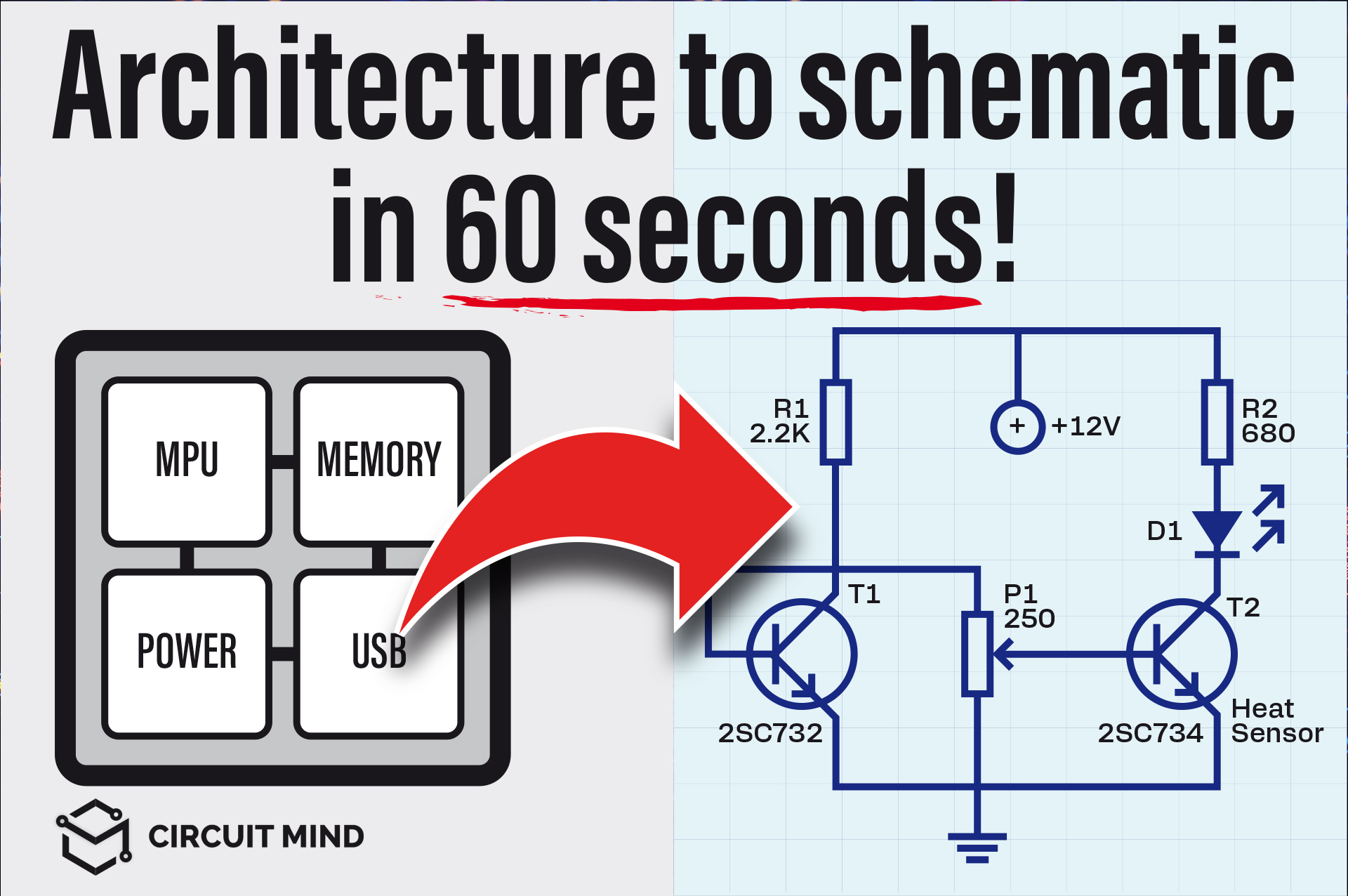Products
Solutions
Published
19 May 2025
Written by Harry Forster
Save Days of Work with Circuit Mind’s ACE Tool
Creating schematics and sourcing components can take days—sometimes weeks. With Circuit Mind’s ACE, engineers can now handle this entire process in just minutes.
ACE stands for Automated Circuit Engineering. It takes your block diagram and turns it into:
- A complete schematic
- A bill of materials (BOM)
- Power and derating analysis
- Failure modes and effects analysis (FMEA)
All of this happens in under 10 minutes.
Who Uses ACE—and Why?
ACE is made for professional electronics engineers who need to:
- Build faster prototypes
- Speed up new product development
- Reduce risk from manual errors
- Evaluate multiple architectures easily
Whether you’re in aerospace, industrial design, or consumer tech, ACE helps speed up your workflow. In particular, it works best when your project is mainly digital or power-based—which applies to most early-stage hardware design.
How ACE Works
Instead of drawing your diagram in PowerPoint or Vizio, start in ACE’s visual interface. You simply:
- Drag and drop your blocks
- Add constraints like memory size or preferred microcontroller family
- Choose trade-offs using sliders (cost, size, power)
- Click “Generate”
Within minutes, ACE analyses trillions of component combinations to give you optimized designs. You don’t just get one option—you get several, each tailored to your needs.
Why ACE Is Different
Many tools speed up part of the design. ACE tackles the entire front-end process. It not only finds components, but also:
- Connects them correctly
- Adds necessary passives and pull-ups
- Matches your constraints
- Runs key design checks like derating and FMEA
Best of all, the results are easy to explore and export into your favorite EDA tool, whether it’s Altium, PADS, Zuken, or others.
What Powers It?
Behind ACE is a second system called Commodore, a huge digital database of electronic components. This database captures what’s in a datasheet, but in a way a machine can understand. It includes everything from pin connections to electrical characteristics.
While Commodore is built using AI, ACE itself uses a deterministic algorithm. That means the designs it generates are predictable, reliable, and repeatable—no guesswork or “AI hallucinations.”
Subscription Model That Scales With You
Circuit Mind offers ACE through a credit-based annual subscription. It’s not tied to the number of users. Instead, you use credits based on project complexity.
This lets engineering teams of all sizes try multiple architectures without committing to extra seats or licenses.
Can You Try It?
Yes—and the evaluation isn’t just a trial. Circuit Mind encourages new users to benchmark the tool against past designs. Upload a previous architecture, and ACE will try to match or beat it—faster, and sometimes bett
Save Days of Work with Circuit Mind’s ACE Tool
Creating schematics and sourcing components can take days—sometimes weeks. With Circuit Mind’s ACE, engineers can now handle this entire process in just minutes.
ACE stands for Automated Circuit Engineering. It takes your block diagram and turns it into:
- A complete schematic
- A bill of materials (BOM)
- Power and derating analysis
- Failure modes and effects analysis (FMEA)
All of this happens in under 10 minutes.
Who Uses ACE—and Why?
ACE is made for professional electronics engineers who need to:
- Build faster prototypes
- Speed up new product development
- Reduce risk from manual errors
- Evaluate multiple architectures easily
Whether you’re in aerospace, industrial design, or consumer tech, ACE helps speed up your workflow. In particular, it works best when your project is mainly digital or power-based—which applies to most early-stage hardware design.
How ACE Works
Instead of drawing your diagram in PowerPoint or Vizio, start in ACE’s visual interface. You simply:
- Drag and drop your blocks
- Add constraints like memory size or preferred microcontroller family
- Choose trade-offs using sliders (cost, size, power)
- Click “Generate”
Within minutes, ACE analyses trillions of component combinations to give you optimized designs. You don’t just get one option—you get several, each tailored to your needs.
Why ACE Is Different
Many tools speed up part of the design. ACE tackles the entire front-end process. It not only finds components, but also:
- Connects them correctly
- Adds necessary passives and pull-ups
- Matches your constraints
- Runs key design checks like derating and FMEA
Best of all, the results are easy to explore and export into your favorite EDA tool, whether it’s Altium, PADS, Zuken, or others.
What Powers It?
Behind ACE is a second system called Commodore, a huge digital database of electronic components. This database captures what’s in a datasheet, but in a way a machine can understand. It includes everything from pin connections to electrical characteristics.
While Commodore is built using AI, ACE itself uses a deterministic algorithm. That means the designs it generates are predictable, reliable, and repeatable—no guesswork or “AI hallucinations.”
Subscription Model That Scales With You
Circuit Mind offers ACE through a credit-based annual subscription. It’s not tied to the number of users. Instead, you use credits based on project complexity.
This lets engineering teams of all sizes try multiple architectures without committing to extra seats or licenses.
Can You Try It?
Yes—and the evaluation isn’t just a trial. Circuit Mind encourages new users to benchmark the tool against past designs. Upload a previous architecture, and ACE will try to match or beat it—faster, and sometimes better.
Visit our electronics components news hub to see the latest updates and insights on innovative and disruptive technologies for embedded systems.
Comments are closed.

Comments
No comments yet